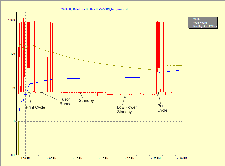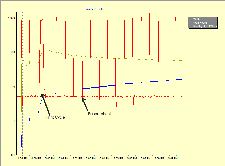A question came up about whether a laser printer would work with an inverter. I first started running an HP LaserJet II on a pure square wave inverter about 20 years ago. Not a pseudo-sine inverter but a brute-force square wave, produced by a “baseband” (60hz) Tripp-lite inverter. This thing was a simple transformer-based blocking oscillator that ran at 60 hz, more or less.
The LaserJet ran just fine, as did my office’s computers on another inverter. These two inverters and a large bank of batteries and a 250 amp, 14 volt analog power supply from a Univac mainframe constituted my full-time UPS.
Fast-forward to the present. My current laser printer is a Brother HL-5250DN, a sweet little printer that they practically give away. Supplies are fairly inexpensive, far less expensive than HP crap.
I’ve just completed two runs with this printer and a Watts-Up ProES Plus power logger. The first run was using line power to demonstrate the characteristics of the printer. Here is a chart of the printer’s characteristics , taken from the Watts Up.
This shows the characteristic power demand of the printer. The major power consumer is the fuser heater that fuses the toner to the paper. After an initial warm-up, the printer goes into a low power standby mode. The fuser is periodically reheated to keep it at the ready. After so many minutes pass without a print job, the printer goes into a lower power standby mode. The fuser is allowed to cool. After even more time passes, the display leds are extinguished and it goes into a sleep mode.
When awakened by another print job, a few seconds of high power consumption pass while the fuser warms. Then the printer runs the print cycle normally
The second run was via a long extension cord out to my motorhome, connected to the 1500 watt Power-On-Board pseudo-sine inverter that powers the rig. This is the inverter that Sam’s Club sold for a long time, priced at $79 and then $59 dollars. It’s a fine inverter, with good overload ability and auto-fault reset. Here is the chart of the laser printer running on the power from this inverter.
Needless to say, the printer worked just fine. I carry the printer along with me on the road when I travel so this is old news. Even though the supply voltage drops considerably during fuser heating because of the long, light extension cord, the switchmode power supply inside the printer compensates, drawing more amps to supply the necessary watts.
Though I’m not willing to test my theory, I bet that the printer would work just fine on about 170 volts DC. Many other SMPS do.
The raw data, both as output from the Watts Up and in the form of an Excel spreadsheet can be downloaded here. [3]
The program that can open and view the raw data contained in the .txt files can be downloaded here [4].

